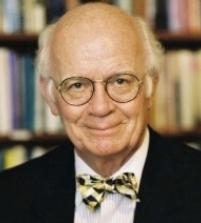
Still Searching for a Usable Future
Contemplating religion's role today in predicting and projecting possible futures
Early in each year, as we face new deadlines, columnists whose writings appear on this page may find reason to reflect afresh on what exactly we are trying to do in this thing we call Sightings. So what is a “sighting?” The Free Dictionary defines it as the “act of catching sight of something, especially something ‘unusual or searched for.’” We are charged to search for instances of “religion in public life,” and find many of them to indeed be “unusual.” We reflect elements of our world (and some presumed worlds) that might interest our readers.
Our world—the United States, that is—unsurprisingly zeroes in on politics and political campaigns in a national election year. People who have a platform and an audience, whether in media, politics, editing, or preaching, inevitably act with some view or other of the future. One hears predictions, projections, arguments, and pronouncements about potential winners or losers in the various games of life. Those of us who “get around,” whether on campuses, in town halls, sanctuaries, or bars, sometimes get challenged with the question: what do you predict? When, for example, I am asked to foretell outcomes expectable this upcoming November, I usually shrug off predictions. After all, I am a historian, and historians deal with the past, not the future. Sixty years ago, having just read Henry Steele Commager’s The Search for a Usable Past, I undertook an admittedly ambitious project, the “search for a usable future,” something I’m still pursuing.
Of course, many historians, whether in the classroom, bar, or vestry, move beyond all this, and are, yes, expected to offer predictions. Predicting is a favorite pastime of humans, even today. It happens at racetracks, on game shows, when they are reckless, and when informed people are not at hand to raise questions about their visions. Projecting, however, is a more disciplined approach to the future, since it draws on what one learns from the past and then envisions potential outcomes based on them. Scholars will often discipline themselves by reviewing their own past predictions and projections. We do such when, for example, we propose budgets and use them to guide economic life, or when we plan careers or retirements and their entailed risks.
Typical of instruments for this disciplining is the effort in Crummy, which is the webspace of Leonard Richardson, who studies and reports on “old books of futurism.” Reviewing The Year 2000 in the year 2008, he helpfully provided one-line statistical summaries of 135 notable predictions offered by others. He noted “27 hits and 22 partial hits,” e.g., “relatively effective appetite and weight control.” Ho-hum. After one hundred of these, Crummy’s author noted twenty-five “less likely but important possibilities,” such as foreseen “artificial growth of new limbs and organs” or “direct input into human memory banks.” Finally, he conscientiously added “Ten Far-Out Possibilities.” These included “interstellar travel,” and “lifetime immunization against practically all diseases.”
The most serious and prestigious effort to project futures was Herman Kahn and Anthony Wiener’s often-fought-over book from 1967, The Year 2000: A Framework for Speculation on the Next Thirty-Three Years. This Hudson Institute study, published in a grand book whose bold spine lettering—The Year 2000—still scowls from the bookshelves upon many twenty-first century browsers, was very heavy on economic and technological futures, which are of great importance, but would not typically warrant the kind of “sightings” we share here.
Still, dear reader, I think we might find something worthy of a “sighting” today by cracking open this book, aided by the insights of David Jones, who reflected on the book’s projections at the dawn of this millennium in Nature. Jones began by dealing appropriately with the economic future. The projected U.S. GNP for 2000, Jones noted, offered a “best guess of $17 trillion,” but “the published figure for 1998 was $8.5 trillion.” Oops. Then, in the field of technology, we read, “Kahn and Wiener’s few accurate predictions dealt mostly with electronic communications,” despite the fact that “technology has not advanced as dramatically as they had guessed.” Third, Jones reviewed political prophecies, and especially their miscalculations (or maybe their hopes) about the collapse of communism around the globe—“only the simple-minded genius of Ronald Reagan ever imagined that outcome.” Fourth, “the most interesting speculations in the book are sociological.” Jones charges that it was “the dangerous optimism of the 1960s” that led to serious mis-projections by many futurists, all of whom failed to forecast “the feminist revolution, the environmental movements, the growth of global migration and ethnic cleansing, [and] the eruptions of AIDS.” He reckoned that “all these would have been beyond the most insightful of prophets,” so Kahn and Wiener can be forgiven for missing them perhaps, along with “electronic totalitarianism” and “the erosion of privacy.”
Few of these projections, we have to note, dealt with specific theological, ecclesiastical, or spiritual visions. The worlds of “religion” and “spirituality” and “prophecy” have always been rich in visions of the future, but they fall beyond the formal disciplines of most of the secular calculators. I still wonder, all these years after beginning my “search for a usable future,” whether these distinct-yet-similar projects of future-casting—religious prophecy and "secular” foretelling—have things to say to one another, lessons to learn from one another. Future Sightings columns will no doubt deal with these topics (and they will do so brilliantly, I predict!). In any case, I think it is safe to say that the “search for a usable future” is still very much alive … and very much needed. ♦
Sightings is edited by Joel Brown, a PhD Candidate in Religions in the Americas at the Divinity School. Sign up here to receive Sightings via email. You can also follow us on Facebook and Twitter. The views and opinions expressed in this article are those of the author and do not necessarily reflect the position of the Marty Center or its editor.


